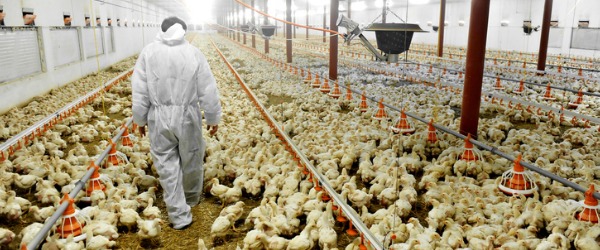What is a Poultry Farmer?
A poultry farmer is someone who raises domesticated birds such as geese, ducks, turkeys or chickens for the purpose of farming meat or eggs for sale and consumption. A poultry farmer typically raises a single type of poultry, with more than half of the poultry farming industry raising chickens.
What does a Poultry Farmer do?

There are typically four types of poultry that a farmer can raise:
Chickens -
The most common type of poultry farm raises chickens. Chickens may be farmed for their eggs or meat. Chicken farmers are in charge of making sure their coops are regularly cleaned of all fecal matter to reduce the risk of spreading disease among the chickens. They also make sure that the chickens have fresh feed and water in the morning. Farmers will take a walk through the chicken coops a few times a day for two reasons: they want the chickens to become accustomed to people and it allows the farmer to check for any chickens that seem sick or injured. They also ensure that the ventilation and temperature of the coop is at an ideal level for the chickens.
Some chickens may spend their whole lives in a warehouse. Here, they are fed, watered, and then shipped to the production plant for slaughter. On some farms, chickens are classified as free range, which means they are free to roam outside in an enclosed space like a field. Both habitats have their advantages and disadvantages.
In the past few years, there has been an increase in demand for ethically farmed poultry, which includes adequate health care and enough space to roam where the chickens can interact with each other, perch, and peck at objects they find interesting. It’s important that chickens are able to express their normal behaviour. Many poultry consumers no longer want to support large commercial farms that overcrowd the birds or mistreat them.
Ducks -
Commercial duck farms are operations similar to chicken farms. Duck meat production is therefore a full-time business requiring investment in both time and money. While duck farming is quite small in comparison to chicken farming, it is expanding rapidly, with increasing global demand. This makes duck farming an attractive option for those considering it as a career. There are more than 40 breeds of domestic ducks, but the Pekin duck is the most common variety raised for eggs and meat (not to be confused with the Peking duck dish).
Typical duties include providing water and feed, monitoring feed consumption, cleaning the living area and maintaining specific hygienic standards, monitoring temperature and humidity, keeping track of growth rates and recording mortalities. Ducks are fed corn and soybeans fortified with vitamins and minerals, and their feed contains no animal by-products. Almost all ducks are raised indoors to protect them from predators as well as to collect their manure, which is used elsewhere selectively as fertilizer.
Geese -
Geese are raised in practically all parts of the United States, although they total only 0.2 percent of the poultry population. On large goose growing farms, the number of birds is from three to four thousand birds, and on the smallest farms around 500 birds are grown.
Geese are mainly kept for meat production, so the breeding birds are selected based on their quick growth, early-maturity and meaty bodies. There are differences in breeds of geese, so their characteristics should be evaluated in order to best meet the producer's requirements. If birds are to be kept for breeding, then egg production and reproductive efficiency are important things to look at. If the geese are raised only for market, the market's meat production and body requirements are of major importance.
The increasing demand for young commercial geese has resulted in the construction of large farms where geese are grown in poultry houses under controlled conditions and with automatic feeding and watering equipment. Geese are quite hardy and not susceptible to many of the common poultry diseases so medicated feed is not generally necessary.
Turkeys -
All commercial turkeys produced today are the white broad breasted turkey breed. Most turkeys are raised in an environmentally controlled barn-type structure that provides protection from bad weather and predators.
An average turkey farm produces six to seven thousand turkeys, three times a year. A hatching egg farm will raise the breeding turkeys to produce eggs that are collected, sanitized and shipped to a turkey hatchery. The hatchery will then hatch the eggs into young turkeys (or poults), which will then be shipped to commercial turkey farms, where they are housed and raised into adult turkeys. Once the turkeys reach a desired market weight, they are transported to the processor. This growing cycle usually runs until the turkeys grow to be 10-18 weeks of age.
What is the workplace of a Poultry Farmer like?
Many poultry farmers own their own farms, especially the small scale farms with only a few hundred birds. The bigger facilities that house thousands of birds will have more farmers on hand to raise them.
Poultry farmers work seven days a week, sometimes all day to ensure that their birds are taken care of. It’s very important that a farmer is very clean before stepping into the poultry house to prevent the spread of diseases. Much of their work takes place outside or within the poultry residence.
Poultry Farmers are also known as:
Turkey Farmer
Chicken Farmer
Duck Farmer
Goose Farmer